War in the West: The Road to Shiloh
CONSEQUENCES OF THE LOSS
After the fall of Forts Henry and Donelson, everything changed in the Western Theater.
As you follow the white line on the map below, you can see that Confederate General Albert Sidney Johnston felt it necessary to withdraw all his troops from Kentucky. In effect, that state was lost to the Confederacy and the Ohio River would never again be the Northern border of the Confederacy.
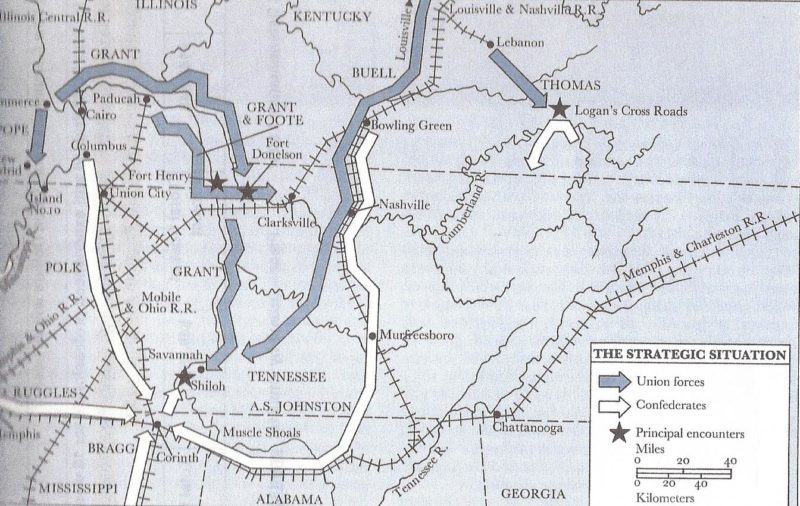 In addition, General Johnston felt it necessary to continue his withdrawal further South. By doing so, he had to also abandon Nashville, Tennessee. This was not only the capital of that state but was also an major industrial and railroad center.
In addition, General Johnston felt it necessary to continue his withdrawal further South. By doing so, he had to also abandon Nashville, Tennessee. This was not only the capital of that state but was also an major industrial and railroad center.
With this withdrawal, the Confederacy also lost Fort Columbus dominating the Northern reaches of the Mississippi River, all of western Tennessee in addition to losing control of both the Tennessee and the Cumberland Rivers.
In effect, Johnston had to establish a new northern border for the Confederacy. By doing so, he also established a new line of defense that stretched from Chattanooga, TE in the East to Corinth, Mississippi in the West. A massive amount of land and resources were thus lost to the Confederacy with the fall of Fort Donelson.
PREPARATIONS FOR RECOVERY
Then Johnston moved his forces to the rail center at Corinth, Mississippi. He and his second in command General Beauregard, gathered men and equipment there from as far away as New Orleans. This was in preparation for an assault on Grant’s army forming twenty some miles away at Pittsburgh Landing, TE. General Johnston was determined to regain the initiative and the lost territory.
Johnston believed he could attack and destroy Grant’s 25,000 man army gathering there. To accomplish that, he had to attack Grant before Union General Buell’s 25,000 man army from the East could join him. So, in March, General Johnston gathered a force equal to Grants at Corinth. (see the map I sent you earlier for an overview of the area)
As plans for his attack were being determined, General Beauregard suggested postponing the attack until the size of their force could be increased. Johnston refused to wait and replied,
“I would attack them even if they were a million.”
UNION’S PROBLEM
All was not well on the Union side either. Not all of Grant’s superior’s were pleased with all the accolades he was receiving after the victory at Fort Donelson. President Lincoln, on the other hand, was happy that he had at last found a general who was willing and able to fight. But Grant’s immediate superior, General Halleck was irritated with Grant’s notoriety and found fault with Grant’s paperwork. He wrote to his superior in Washington City, General McClellan and accused Grant of ‘neglect and inefficiency’. He also accused Grant of returning to his old habit of heavy drinking.
Grant further irritated his superiors by suggesting that he be allowed to send troops to occupy Nashville, TE recently abandoned by the Confederates. His request was denied by General Halleck. Instead, he was ordered to return the 5,000 troops he had been ‘loaned’ from General Buell’s force for the attack on Fort Donelson.
When he received that order, he was on his command ship, the Tigress. Grand considered his options with his staff. He dismissed the notion of disobeying his superior’s order and moving on Nashville himself. He also had to obey the direct order to return the ‘borrowed’ 5,000 men to General Buell.
Grant decided to return the ‘borrowed’ forces to General Buell by sending that force to Nashville to await Buell’s arrival. Thus, Grant obeyed his superior’s order and captured Nashville for the Union without firing a shot. The Northern press loved it, and so did Lincoln. Neither Buell or Halleck liked Grant’s slight of hand move.
Lincoln Steps In
Halleck complained to his superior again about Grant and was reminded that he could always relieve Grant of command or court martial him. Halleck chose to remove Grant from command. Lincoln got wind of it and ordered Halleck to either bring charges against Grant or restore him to command. It seems that Lincoln knew of the jealousy behind the affair and did not want to lose the only successful fighting general he had in either the East or the West.
“I can’t spare that man,” Lincoln was heard to comment at the time. “He fights.”
So, on March 13, 1862 General Grant was returned to his command. He now found himself at Pittsburg Landing, Tennessee (Shiloh) in charge of organizing the largest army the war had yet seen.
The stage was being set for the bloodiest battle of the Civil War up to that time.
General Grant and Cigars
General Grant and Cigar Smoking
It is generally known that General U.S. Grant smoked cigars. During the Civil War period, cigars, pipes and chew were the popular forms of using tobacco. When the war began, Grant enjoyed an occasional cigar.
And when he led the Union forces to victory at Fort Donelson in February 1862, he became a much-publicized hero in the Northern press. At that time, he was pictured in the press during the fighting clenching a cigar in his teeth. So, it was natural that people thought he liked to smoke cigars.
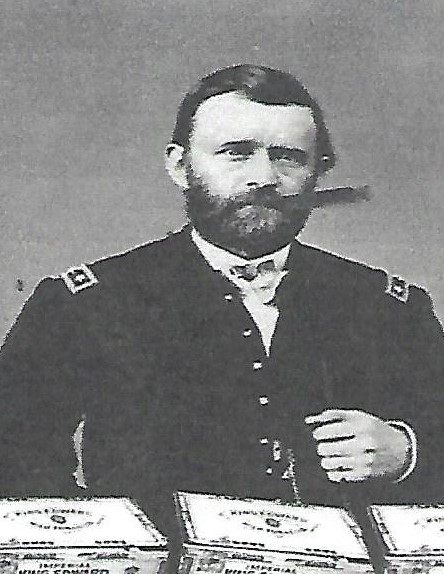
“I had been a light smoker before the attack on Fort Donelson.” He said to an aide. “(But) in the accounts published in the papers, I was represented as smoking a cigar in the midst of the conflict; and many persons, thinking, no doubt, that tobacco was my chief solace, sent me boxes of the choicest brands… As many as ten thousand were soon received. I have away all I could get ride of, but having such a quantity on hand, I naturally smoked more than I would have done under ordinary circumstances, and I have continued ever since.”
His popularity grew when it was reported that General Ulysses S. Grant demanded of the Confederate commander at Ft. Donelson, unconditional surrender of the fort and his 15,000 man army Thereafter, Grant was called ‘Unconditional Surrender Grant.’
The flood of cigars continued. So did his smoking.
He is said to have continued chain smoking cigars while he was President of the United States. Shortly after leaving office, he was diagnosed as having cancer of the mouth/tongue. He died a few days after finishing his hand written memoirs.
Civil War Instant Foods
Instant Foods During the War
In response to wartime problems of transportation and food preservation, enterprising inventors responded to meet this twin wartime emergency.
The first of these problems involved coffee. Union soldiers loved their cup of coffee. But transporting the bulky coffee beans and sugar was a problem. It took too much space in the transportation system used at the time. So, early in the war Secretary of War Cameron sent out a call for a solution. Three proposals to solve the problem are described below.
The most expensive proposal was a process invented by a Professor W. L. Tilden called, Extract of Coffee. His process cost $3.11 per gallon. Another proposal was offered by the American Desicating Company at #3.00 per gallon. The Bordon Company offered a third solution at $2.66 per gallon. All three included sugar. Bordon included it’s milk concentrate as well.
The advantage of all three products was that it used only 45% of the shipping space taken by green coffee beans/sugar The concentrate also weighed only half as much as the raw beans. Thus, the individual soldier found these products much easier to carry.
All three products were tested in the field with soldiers. Tilden’s extract was greeted with enthusiasm in the volunteer regiment where it was tested. It was said that his product,
“…ensured the soldier, on the march or in camp, a supply of coffee as good as could be procured at a first rate hotel.”
Despite its higher cost, Tilden’s proposal was adopted for widespread use by the Union’s military. I was not able to find any mention of what might have gone on behind the scene in the selection process. It is known, however that Secretary of War Cameron was removed from office by President Lincoln after charges of graft surfaced early in the war.
The second problem was that of the need for fresh vegetables. Given the seasonal nature of most vegetables and the additional difficulty of trainspotting them, Union soldiers lacked vegetables in their diets.
Military around the world had always had a problem providing fresh vegetables for their troops. Vegetables spoiled quickly and were heavy and hard to transport when available. So, as early as the Crimean War , a product called desiccated vegetables was developed and issued to the troops involved in that conflict.
The Union adopted its use in Utah before the Civil War began. The product was a mixture of potatoes, cabbage, turnips, carrots, parsnips, beets, tomatoes, onions, peas, beans, lentils and celery. These raw vegetables were cleaned, shredded and mixed. The mixture was put under pressure in a massive press to compress the mix thus moving the juices. The compressed blocks were then dried in large ovens. The resulting blocks were ‘hard as a rock’ but were expected to soften when boiled. It was claimed that a cubic yard of desiccated vegetables would contain 16,000 servings.
But the troops were not impressed with the products, however. One soldier wrote home that:
“We have boiled, fried, stewed, pickled, sweetened, salted and tried this stuff in puddings, cakes and pies. But it sets all modes of cooking in defiance so the boys break it up and smoke it in their pipes.”
Others were said to have called the concoction, ‘desecrated vegetables’.
Civil War Christmas
Civil War Christmas
The Civil War did not stop for Christmas. However, as was customary in 1861, major military activity usually had stopped for the winter months. (note: fighting did not stop in the East after Grant took over.)
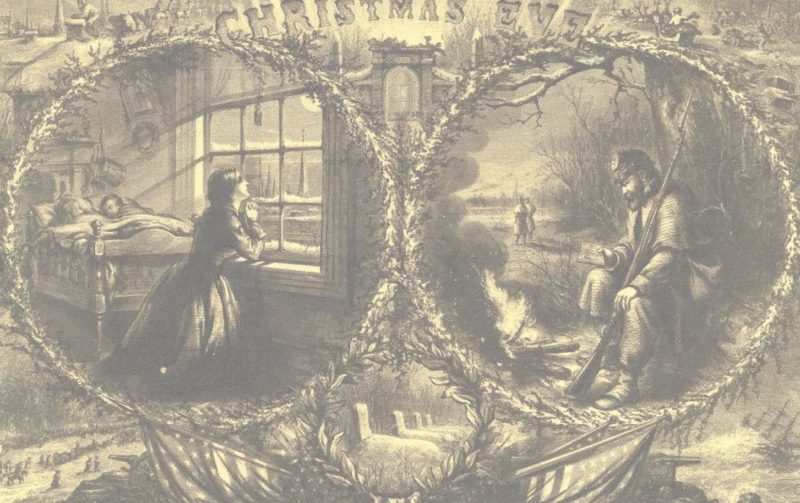
Soldiers on both sides of the conflict did not receive special rations to celebrate Christmas. Many charitable groups sent holiday rations to their troops, though. Officers on both sides sometimes provided treats like foul, holiday fixings and even alcohol for their men.
Christmas trees found their way into tents. Such trees were often decorated with makeshift ornaments by soldiers. Church services were provided in camps to celebrate the birth of Jesus.

Nevertheless, hundreds of thousands of families on both sides were separated during the Christmas season. And, most every family had at least one empty chair at their Christmas dinner.
Military bands played Christmas music and soldiers sang traditional songs. The favorites were, “Deck the Halls, Oh Come All Ye Faithful, Hark the Herald angels, Jingle Bells, It came Upon a Midnight Clear, and We Three Kings.”
Sometimes, men would receive a package from home. usually these were shared with others in their unit. Southern children were told that Santa would not come for Christmas because of the Yankee blockade.
General Sherman sent President Lincoln a greeting in December of 1864 announcing the capture of the Southern city of Savannah, Georgia. He said it was his Christmas present to the President.
The River War in the West #3
Western Theater
Once General Halleck approved the Gen Grant & naval Capt. Foote joint operation to attack Fort Henry on the Tennessee River and Fort Donelson on the Cumberland River, he gave the project all his support. He even transferred 5,000 men to Grants land force from General Buell’s army.

The stakes were high. At stake for the Confederates was their entire position in Kentucky, control of Nashville, Tennessee and the two major rivers commanded by the forts under attack, the fortified position on the Mississippi at Columbus, KY, control of the Memphis – Charleston railroad in the West and potentially a large area of land extending East to Chattanooga, Tennessee and south to the Cotton States.
Grant had difficulty finding adequate transport for his approximate 15,000 man force. Divided into two divisions, he could only move one at a time into position for his move on Fort Henry. that and bad roads ans streams swollen by spring flooding showed him down. So, naval Capt. Andrew Foote began the attack on Feb. 6th, 1862 against Fort Henry without infantry support.
His ironclads led the attack firing directly into the fort. The timber- clads under his command followed in line to lob mortar shells into Fort Henry. In short order the fort’s building and tents were ablaze and only four of it’s eleven guns remained in operation. But, the Confederates gave as good as they got, damaging several of the Federal boats. Facing the arrival of Grands force though, the Confederate commander General Tilghman ordered the white flag of surrender raised and directed his soldiers who remained fit for duty to leave for Fort Donelson twelve miles away.
Several of Capt Foote’s boats had been damaged seriously enough during the fight to be withdrawn and repaired. They would not be available for the attack on Fort Donelson located on the Cumberland River. So, while the victory at Fort Henry had been a naval victory, the infantry under Gen. Grant would have to lead the assault on Fort Donelson.
Drieborg Chronicle Book Sales
Just to let you know, I just mailed out eight books from the seven book Civil War series, the Drieborg Chronicles. all of them were purchased from the web site www.civilwarnovels.com and Pay Pal. Amazon notified me that another seventeen books from this series were purchased and shipped by them to buyers.
Check out purchases from this series for Christmas. If you are getting one or more of these books as a first time gift, start with the novel 1860, then Duty and Honor, Duty Accomplished, Honor Restored, The Lincoln Assassination, The Way West and finally Civil War Prisons.
Early Moves on the Western Waters 1861-1862
The River War 1861 – 1862
General Winfield Scott’s plan to defeat the Confederate States needed a river navy to succeed in the West and an ocean navy to succeed in the East. In the last blog, I outlined the creation of the Brown River Navy with the building of the Pook boats under the direction of an engineer named Eads. Before those boats were delivered at the end of 1861, steam driven river paddle boats were refitted to carry troops & supplies with others armed with mortars and artillery to support military activity on the Western rivers.
The first of such military activity was on September 3rd, 1861 at Columbus, KY when CSA General Polk occupied the eastern bluffs at this site to dominate the Mississippi River just south of Cairo, IL
Then, on September 6th, under orders from General Fremont, General Grant took a force up the Ohio River and occupied Paducah, KY. Located on the Ohio River. The fort at Paducah gave the Union control of the exits of the Ohio, Tennessee and Cumberland Rivers. Grant’s force occupied the city and it’s dominating fort without firing a shot. His move preceded a Confederate force that was just sixteen miles East, moving to take the river city for the CSA.

Subsequently, General Fremont was replace by General Halleck. Not a Grant supporter, Halleck non-the-less ordered Grant to attack Confederate forces at Belmont, MO south of Cairo, Ill. It was on the West side of the 800 yard wide Mississippi River across from the Confederate stronghold of Columbus, KY.
So, Grant loaded his troops on converted river boats and moved his force South from Cairo, IL.. They unloaded north of Belmont early in the morning and surprised the Confederate force there. Grant’s force was later repulsed, retreating to the river where they left the area on their river transports under the protective fire of Union gunboats.
Back in Washington City, President Lincoln was pressing for more action in the Western theater. General Halleck, much like his superior General-in-Chief McClellan hesitated to attack Confederate positions in his theater of operations. General Grant proposed an attack on Forts Henry and Donelson.
See the map I sent you earlier.
Capturing these two positions for the Union would be catastrophic for the CSA’s war strategy in the West. Never-the-less, Halleck denied Grant permission to proceed. We will cover this issue in a future blog.
Early Thanksgiving Celebrations
Thanksgiving
The first such Thanksgiving celebration likely happened between September and November in the Plymouth Bay colony pf 1821. It was a day set aside to thank the Lord for the harvest. Whether or not they were invited, 90 Wampanoag Indians under the leader Massasoit attended. Edward Winslow said of the event:
“Our harvest being gotten in, our governor sent four men on fowling, that so we might after a special manner rejoice together, after we had gathered the fruits of our labors; they four in one day killed as much fowl, as with a little help beside, served the company almost a week, at which time amongst other recreations, we exercised our arms, many of the Indians coming amongst us, and amongst the rest their greatest king Massasoit, with some ninety men whom for three days we entertained and feasted, and they went out and killed five deer.”

What was served at this first thanksgiving in the Plymouth Colony? As you read from Winslow’s quote, fowl and deer were served. It is reported by Sara Josepha Hale in the Goody’s Lady’s Book that turkey was the fowl served. In addition, fish, mussels and oysters, corn dishes,and breads were prepared for all the attendees.
The custom continued in New England after the fall harvest but not in the rest of the country. The Continental Congress declared the first national Thanksgiving to be celebrated on December 8, 1777. In 1789, George Washington declared the fourth Thursday of November a day of thanksgiving and prayer. James Madison did likewise during his presidency. Few future presidents did this.
But in 1845, Sarah Josepha Hale began campaigning for such an annual day of thanksgiving. Finally in 1863, (During the Civil War) Abraham Lincoln declared the last Thursday in November to be a national day of day of thanks, and a holiday.
“It seems to me fit and proper that they (gifts) should be solemnly, reverently and gratefully acknowledged as with one heart and one voice by the whole American people. I do therefore, invite my fellow citizens to every part of the United States, and also those who are at seas and those who are sojourning in foreign lands, to set apart and observe the last Thursday of November as a Day of Thanksgiving and Prayer to our beneficent Father who dwelleth in the heavens.”
New York volunteers sent 400,000 pounds of turkey by ship to Grant’s army at City Point, VA for the observance of Thanksgiving in 1863. The observance of Thanksgiving continued to be celebrated on the last Thursday of November until President Roosevelt changed it to the fourth Thursday of November. It was codified into law in December 1941. It has remained a national legal holiday on the fourth Thursday of November ever since.
The next blog will review the first major Union victory of the war. Do you remember it? It was during the winter of 1862. Was it in the East or the West? Tune in during December. Happy Thanksgiving all.
General Scott’s Grand Design (April 1862)
Union War Strategy
Before Fort Sumter was fired upon by Confederate forces in Charleston, South Carolina, President Lincoln asked General Scott to give him advice concerning the use of force to solve the secession issue in general and the holding of Forts Sumter and Pickins in particular.
The General advised the President that the Union could not hold Sumter against attack or recapture it without a civil war. He followed this observation with the opinion that a war to force the seceding states back into the Union would take a huge army, great loss of life and treasure and several years to accomplish. In addition, such a war would entail such widespread devastation in the South that bitterness and hatred between the sections would last for generations.
So, he recommended that President Lincoln turn over the two forts over to Confederate control and allow the cotton states to leave the Union in peace.
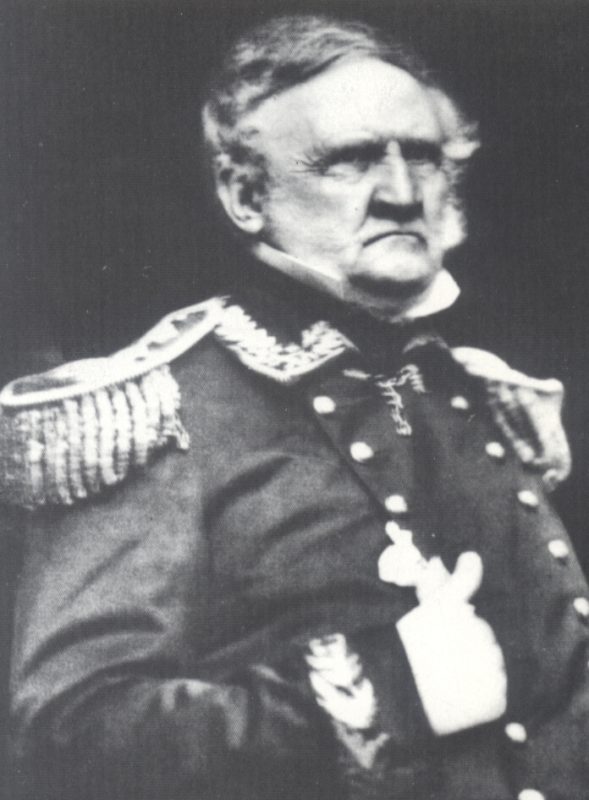
A P Johnston
Lincoln rejected General Scott’s recommendation.
After Fort Sumter was fired upon and captured by Confederate forces, Lincoln once again asked his chief military adviser for his recommendations given the new situation.
The United States had been attacked. So, this time Lincoln was asking General Scott to give him recommendations about how to win a war. The general recommended several steps be taken immediately.
First: Create a blockade of the Confederate States preventing all commerce with the outside world.
Second: Immediately begin a campaign to recapture control of the Mississippi River and it’s tributaries.
Third: Do not invade the Confederate States of America in the East; rather control the eastern boarders.
He believed that by employing this overall strategy, the Union would accomplish it’s Primary Goal of re-uniting the country, avoiding massive destruction within the Confederate states and avoiding great loss of life and treasure.
Lincoln agreed and immediately implemented the first recommendation by declaring an Embargo of all the ports of the Confederacy, warning all the nations of the world that they would be prevented from trading with the states in secession.
And secondly, the War Department took the first step in reclaiming control of the Mississippi River by authorizing the creation of a Brown River Navy to be operational by January 1862.
The third strategy recommended by Scott of a holding action in the East immediately came under fire from the Northern press. ‘On to Richmond’ was their daily chant. Attack and finish this rebellion quickly, their goal. Lincoln was accused of everything from cowardice to being a traitor for not attacking the Confederacy in the East. So, he and his cabinet caved to the pressure and ordered General McDowell to gather the newly formed and untested Union volunteer army and attack southward to Richmond.
The South’s hero of Fort Sumter, General Beauregard, waited with his 60,000 untrained trained men for the attack of McDowell’s force of the similar size. The two poorly trained, untested and newly organized forces fought at a place called Bull Run. With last minute reinforcements sent via train under Confederate General Joe Johnston, the Union force was routed. As a result, the Union capital was left virtually undefended. The Confederates did not pursue their advantage.
 In the immediate aftermath of this overwhelming victory , Confederate President Jefferson Davis, refused to press the attack against the North. He failed to get the CSA’s finances or rail lines in order either. He, withheld the CSA’s cotton from Europe, and thus did not earn the funds needed to strengthen its military capability with equipment delivered from Europe before the Northern embargo tightened. An additional factor was that he sought to fight a defensive war.
In the immediate aftermath of this overwhelming victory , Confederate President Jefferson Davis, refused to press the attack against the North. He failed to get the CSA’s finances or rail lines in order either. He, withheld the CSA’s cotton from Europe, and thus did not earn the funds needed to strengthen its military capability with equipment delivered from Europe before the Northern embargo tightened. An additional factor was that he sought to fight a defensive war.
He gave Lincoln and the Union what it needed most, time. Time was given the Union to organize a war-time economy, to establish control of its rail systems, reorganize and equip an overwhelming army in the East and another in the West. A river navy authorized in July would be ready in 1862, to begin regaining control of the Ohio, Tennessee,& Cumberland Rivers and eventually, the mighty Mississippi River. And he gave it time to build a high seas navy more capable of enforcing the Union embargo of the South.
So, the consequence of President Davis’s defensive tactic put all the major Western rivers in Union hands by the end of April 1862. And, Lincoln’s forces would control all but Vicksburg on the Mississippi River from Memphis to New Orleans. As a result, the Confederacy would be almost split in half, the embargo would be more effective and the Confederate heartland would soon be open to invasion.
By the end of 1862, the North was ready. The River Navy was on the water, the ocean Navy was enlarged, the blockade was becoming more effective by the day, the huge Army of the Potomac was ready to invade in the East. And, in the West, the Union army was ready to take on the superior land forces of the Confederacy.
The defensive strategy dictated by Confederate President Davis had given what the Union needed most after the Bull Run defeat: time. Davis and his people did not use this time well. Lincoln and his people did.
So, now it is time for us to begin chronicling the War in the West. Get out your map and find Cairo, Ill. That is where we will begin next week. See you then.
Civil War Railroads #3
Civil War Railroads
Miles of Track:
In 1861, there was 21,300 miles of track & 45,000 miles of telegraph wire in the North. By 1865 the North had the largest system in the world.
In the South, there was 8,947 miles of track & 5,000 miles of telegraph wire when the war began. Virtually the entire system was destroyed by war.
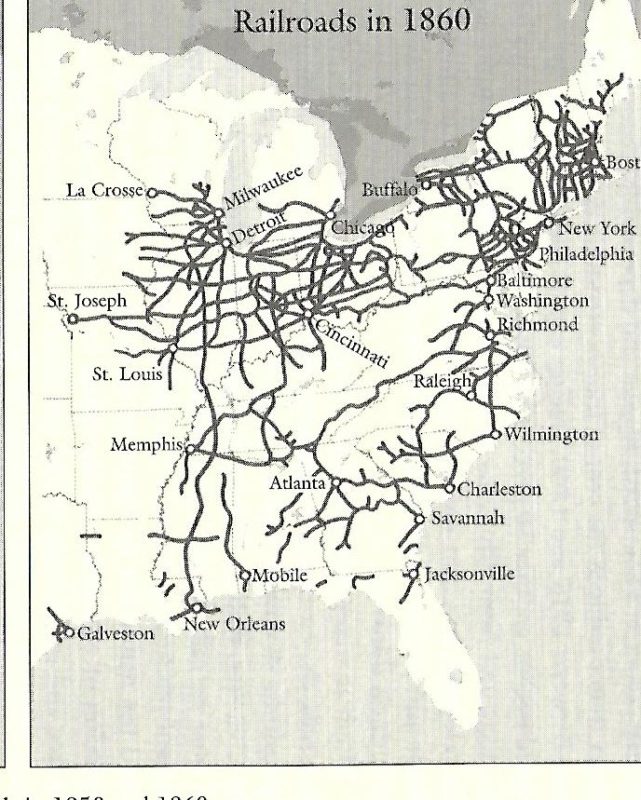
Railroad Act of 1861
Both North & south passed legislation allowing governments to take over control of railroads for military purposes.
Railroad Connections
N – In the North railroads connect all major cities and 88% of farmers were no more than five miles from a railroad.
S – In the South railroads were built to connect cotton centers to navigable rivers & ports. Pre-war private capital was invested in land & slaves not railroads.
N – All one track gauges were used.
S – Four tract gauges were used.
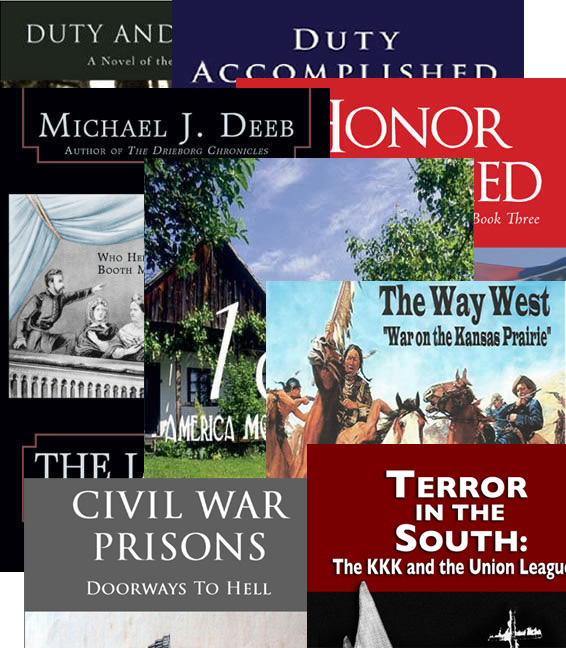
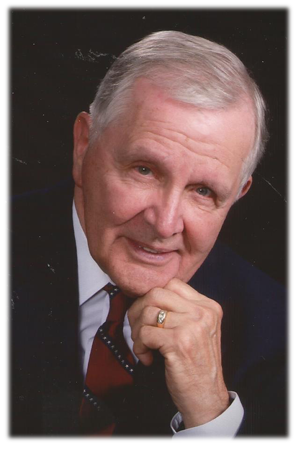
 A Great Read! I couldn’t put this book down once I got started. The detail was great and I really like the main character, Michael. Knowing that so much research went into this book made it exciting to read!
A Great Read! I couldn’t put this book down once I got started. The detail was great and I really like the main character, Michael. Knowing that so much research went into this book made it exciting to read!